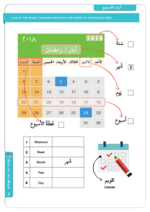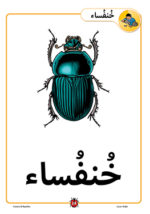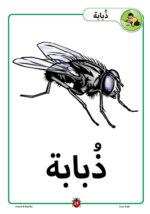Description
This worksheet is very helpful for nursery and primary teachers as much as it is for parents who want their children to be familiar with Arabic words and Arabic script from an early age. All vocabulary items are introduced and illustrated with images.
The worksheet introduces the word (ant) نملة in three stages (pages):
1. presentation stage (seeing and recognising)
2. context stage (reading)
3. awareness stage ( deconstructing and constructing)
In the presentation stage, the child sees one image and one word. At this point, the child links the image to the word. English is not used with Arabic as it is less effective when mother language (ML) interference takes place. In other words, it is not recommended at this stage to use (ML). When (ML) interference is mimimum, language acquisition is likely to progress and the child learns faster. It is recommended that teachers or parents do not translate to the child even if the child can say the meaning in their (ML). It is acceptable to appreciate that the child knows the word in (ML) but parents at this stage should not respond by repeating the word in (ML). After repeating the word several times in Arabic, the child is ready to be guided to the next page.
In the context stage (I read), the child sees the same word but within context. The context is a very simple dialogue of a question and an answer:
A – What is this?
B – It is a/an …….
The teacher/ parent should read the question and answer in Arabic to the child so he/she can hear the sound and understand the process. After that, the teacher/parent can point to the image above the dialogue and ask the question to the child. The child should be given the chance and time to think and figure out what to do or answer. The child can only say the name of the animal. However, it is much better if the child uses the demonstrative (this is) with the name of the animal.
As a rewarding and reinforcing entertainment in this stage, the child colour sin the dotted word using the same colours of the coloured word. This task (I colour) is very important as it will give the child a sense of reading and writing in Arabic while they are enjoying the colouring activity. This task (I colour) will also reinforce the word shape and meaning in memory and prepares the child to the third stage.
In the awareness stage( I deconstruct and construct), the child does two tasks: the first one is to make a decision about the correct letter order where the name of the animal is given in a box. The child has to look at the shape of the word and try to choose the set with the correct letter order. In this task, the child practices to mentally deconstruct the word and compare it to the two options.Thus, they become aware of the fact that words are made of letters and that their order is essential to make the word hold particular meaning.
These phases are followed throughout the whole book. When the child has reached the end of the book they will have acquired and developed many mental skills such as: recognising the words, letters and letter orders in addition to using the language in the second stage (I read) and physical skills such as: using the hand to colour precisely, and using the eye to recognise the word and letter shapes.
IMPORTANT NOTE
It is highly recommended that the teacher/ parent see the list of instructions in Arabic translations in case they do not know how to read Arabic so they can imitate the sounds when they are helping the child. English instructions are minimally used for a professional purpose. The main purpose is to minimise the use of (ML) when the eye is looking at the script. This will enhance linking the identifying word to the identified image.












Reviews
There are no reviews yet.